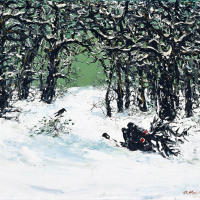6. ARTHUR BOYD

After establishing himself as a leading artist in Australia with the Bride series, Arthur Boyd travelled to London with his family in 1959, where they remained until 1971. Boyd extended his success from Australia to Europe by exhibiting at numerous London galleries throughout the 1960s. A solo show at the Zwemmer Gallery in 1960 and a retrospective at Whitechapel Gallery in 1962 earned him immediate and positive critical reception: the market was agog, and the media attended in droves.1
The Boyds initially rented at 13 Hampstead Lane, Highgate, just north-east of Hampstead Heath, before relocating in 1962 to 43 Flask Walk, Hampstead, just south-west of Hampstead Heath. A few years later in 1965 they bought their previous home at 13 Hampstead Lane.2 Snow Landscape, Hampstead is believed to have been painted during one of these long London winters, depicting the snowy woodlands of nearby Hampstead Heath. Boyd was clearly fond of these white winter landscapes, so rare in Australia, and painted similar works in Suffolk where the Boyds rented a cottage from 1969.
The present work is similar in subject to a painting held in the collection of the National Gallery of Australia, Winter Landscape 1960 (see Figure 1). Both paintings depict a snowy scene with dark, foreboding trees forming a clearing, in which a black deer with antlers and red eyes is accompanied by a single black bird. They are thought to have been painted at a similar time, when Boyd was living in Hampstead, but employ rather different painterly styles. Unlike the naturalistic NGA painting, the present work exhibits far more expressive brushwork whipped into impasto peaks, similar to Boyds Nebuchadnezzar paintings from later in the decade. Here, the deer appears to be in turmoil, upside down and half buried in snow. The animal is stylistically akin to the raucous lion in his Nebuchadnezzar scenes, while the little bird, a ubiquitous motif in all Boyds landscapes, watches on in apparent peace.
The deers evident agitation, eyes wide and mouth open, in a distraught bleat, is reminiscent of August Friedrich Schencks (1828-1901) Anguish c1878 in the National Gallery of Victoria collection. Anguish depicts a distressed sheep in a field of snow, mouth wide bleating into the frosty air, as black crows gather around the lifeless lamb at her feet. It is a highly emotive painting with which Boyd must have been familiar, and the similarities with Snow Landscape, Hampstead are undeniable.
The landscape genre is one that Boyd repeatedly revisited throughout his life. Between his intensely imaginative bouts of figurative painting, Boyd returned to the tranquillity of landscape painting almost as a palate cleanser. Snow Landscape, Hampstead was produced at a similar time to his heavily allegorical Nude with Beast series and not long before his mythological Nebuchadnezzar series. During this period in London his works often focused on the idea of metamorphosis, inspired by two of his favourite paintings in the National Gallery, London: Piero di Cosimos The Death of Procris (Satyr Mourning over a Nymph) and Titians The Death of Actaeon. Hints of this can be seen in Snow Landscape, Hampstead with the semi-submerged deer adding an allegorical element, as opposed to the placid, unassuming version in the NGA. Having been held in one family since its initial purchase in 1968, this rare example of Boyds English snowscapes now comes to auction for the first time.
Footnotes
1. McKenzie, J., Arthur Boyd: Art & Life, Thames & Hudson, London, 2000, p.104
2. Hoff, U., The Art of Arthur Boyd, Andr Deutsch Limited, London, 1986, pp.222-224
Asta Cameron